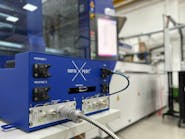
I have been seeing more and more television ads about how 5G is going to revolutionize manufacturing. I am not sure if that will happen before or after the Internet of Things or Industry 4.0 or artificial intelligence or machine learning revolutionizes it.
But if you are in charge of a manufacturing operation now or hope to be in charge someday, it is certainly worth thinking about, because slowly implementing 5G is probably better than trying to do it all at once. It will be a big challenge using a 5G network with existing legacy equipment.
Fifth-generation wireless communications operate on a less-crowded, higher-frequency spectrum of around 6 gigahertz (GHz), or by using millimeter waves on new radio frequencies as great as 300 GHz. For manufacturing, 5G promises networks that are faster, more consistent and have high capacity. The fastest 5G networks are expected to be at least 10 times faster than current 4G networks.
Self-driving cars and future health-care systems will depend on 5G networks. Consumers will use it to shift more and more of their internet time from a computer or laptop to their smartphones. One analyst has predicted that by 2025, more than 72 percent of people will access the internet solely from their smartphones.
Some plastics processing plants already have thousands of sensors delivering information to controllers and storage devices. Unfortunately, it is often a patchwork of networks inside the company because of security or capacity or connectivity issues.
Machine-to-machine communication is becoming more important. It is needed to make automation more efficient and enable faster network monitoring. This is how Dheeraj Remella, CPO of VoltDB Inc., described the promise of 5G to IndustryWeek earlier this year:
“As 5G continues to roll out, the manufacturing industry is expected to benefit greatly from the network’s increased connectivity and speed, using its intelligent connectivity to drive robotic process automation sensors and modernized Supervisory Control And Data Acquisition (SCADA) systems to incorporate decisions and actions in real-time in addition to acquisition. The enhanced speed and scale of 5G is expected to help streamline production, improve product quality and reduce machinery downtime.”
The first 5G networks appeared in 2018 and thus far, slightly more than 20 cities have the service, sometimes available only in small areas.
All of the major telecom carriers are promising 5G, but there are competing systems and a clear winner has not yet emerged.
Making the switch to 5G won’t be cheap, but the promise of replacing wired networks inside a plant can make it an attractive option. Untethering motion-control systems and vision systems — anything that needs a lot of computing power — from Ethernet is a selling point.
Because of the spectrums 5G operates on, signals can be easily blocked by solid obstacles and impaired by rain or humidity. One way to get ready now is to start installing small cell networks with small antennas close together to optimize connectivity. The antennas are about the size of a pizza box.
Remella predicts that companies that invest in IoT capabilities now will be among the first beneficiaries of 5G because they can easily add small cell technology inside their plants.
How long do we have to wait? The Ericsson Mobility Report predicts that by the end of 2024, 35 percent of all traffic will be carried over 5G networks and up to 65 percent of the global population will have access to 5G.
What is it going to cost? It’s too early to say, but productivity gains might make it a good investment once it is available in your area.
Cybersecurity
The coming 5G wireless communications systems will bring new security problems. Huge amounts of data will be flowing through networks, possibly making them targets for more hackers and mischief-makers.
But there is interesting research into using AI to instantly spot anomalies in your network traffic, allowing immediate response to block unauthorized access.
Cybersecurity is an issue that impacts our businesses now. For insights, you should read the excellent stories about cybersecurity by Bruce Geiselman starting on page 7.
It is always striking that no matter how complex your networks become, your employees are the first and most important line of defense.
There are also firms specializing in network security that can lend a hand in preventing unauthorized intrusions and repairing the damage.
Especially interesting is the idea of hiring authorized hackers to test your systems.
There is a lot of valuable information in these stories.
Ron Shinn, editor
Ron Shinn | Editor
Editor Ron Shinn is a co-founder of Plastics Machinery & Manufacturing and has been covering the plastics industry for more than 35 years. He leads the editorial team, directs coverage and sets the editorial calendar. He also writes features, including the Talking Points column and On the Factory Floor, and covers recycling and sustainability for PMM and Plastics Recycling.
PLASTICS releases Global Trends report
New CEO named at Kistler Group





